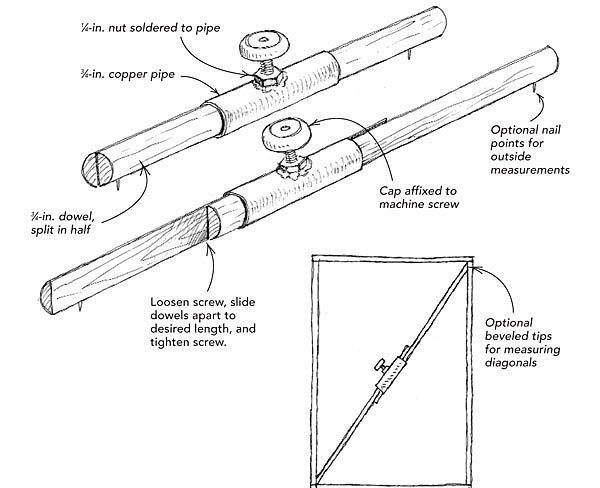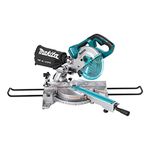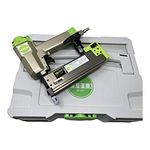Story-Stick Measuring
The handy story stick can help you save time and minimize measuring mistakes.

For those of us plain-vanilla boys and girls who don’t like to remember numbers on tapes or which side of the mark to use, story sticks can simplify a number of measuring situations. You can buy commercially available gadgets that do the same thing (they are called bar gauges), but I’d rather make my own.
Here’s How:
I start with a piece of garden-variety 3/4-in. copper pipe about 4 in. long (see drawing). I drill a hole in its side, then solder a 1/4-in. brass nut to the side of the pipe, centered over the hole. A 1-in. long 1/4-in. machine screw with a knob on one end screws into the nut.
The screw acts as a clamp, bearing against a 3/4-in. dowel that has been split in half. To use this device, you simply loosen the screw and let the dowel halves slide past one another until they bear against the surface of the target. Let’s say it’s an inside measurement for a window jamb. Extend the dowels against the opening, clamp, transfer to workpiece and cut. No numbers required.
Another option is to add nail points to each dowel half, as shown in the drawing. They can be used to transfer outside measurements. For measuring diagonals, as in drawer boxes or picture frames, bevel the ends of the dowels so that they tuck into 90° corners.
— Paul K. Kincaid; Lawrence, KS
From Fine Homebuilding #149
RELATED STORIES
Got a Tip?
Do you have any great tips like this one on how to make and measure with a story stick? Share your methods, tricks, and jigs with other readers. Tag them @FineHomebuilding on social, email them to us at [email protected], or upload them to FineHomebuilding.com/reader-tips. We’ll pay for any we publish.
Fine Homebuilding Recommended Products
Fine Homebuilding receives a commission for items purchased through links on this site, including Amazon Associates and other affiliate advertising programs.

Milwaukee Cordless Shop Vac (0880-20)

Large-Capacity Lightweight Miter Saw

Cadex 18-Gauge Brad Nailer (CB18.50)






























View Comments
cutting a dowel in half is easier said than done. how do you do it?
Perhaps I'm missing something. Why make bevel an option? Shouldn't the measurement be the same (beveled or not) in your example of a window jamb?
I would rotate the dowels 90° such that the machine screw presses against a side of the dowel, not the edges.
Perhaps a fine gadget to make when you're out of work and don't have a project to complete. There's some satisfaction in that. But one has to weigh the time involved to make it against the cost of buying one of those 'commercially available gadgets.'
JMHO.